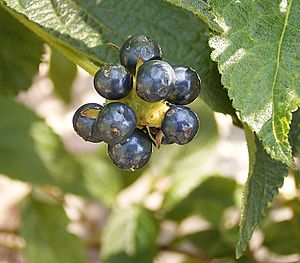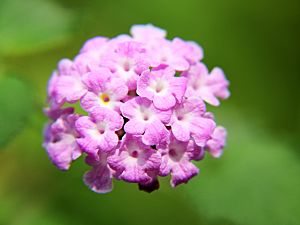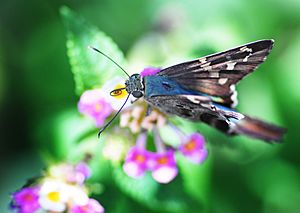Big-sage facts for kids
Quick facts for kids Lantana |
|
|---|---|
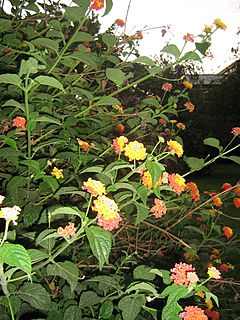 |
|
| Spanish Flag Lantana camara | |
| Scientific classification | |
| Kingdom: | |
| Division: | |
| Class: | |
| Order: | |
| Family: | |
| Genus: |
Lantana
|
Lantana camara, also known as big-sage or wild-sage, is a type of flowering plant. It belongs to the verbena family and originally comes from the American tropics. You might hear it called tickberry in South Africa or red-sage in the Caribbean.
This plant is often grown in gardens because it has pretty flowers. However, it has spread from its home in Central and South America to about 50 other countries. In many places, it has become an invasive species. This means it grows where it's not wanted and can cause problems. Dutch explorers first brought it to Europe, and from there, it quickly spread to Asia and Oceania. It became a well-known weed in these new places.
Lantana camara can take over areas, pushing out other plants that naturally grow there. This can reduce the number of different plant and animal species, which is bad for biodiversity. It can also harm farms because it's poisonous to animals like cows and sheep. Plus, it can grow into thick, dense bushes that make it hard for farmers to use their land.
Contents
What is Lantana camara?
Lantana camara is a small perennial shrub. This means it's a woody plant that lives for more than two years. It can grow up to 2 meters (about 6.5 feet) tall. It often forms thick, dense bushes in many different environments. Over hundreds of years, people have bred many different types of Lantana camara to use as garden plants.
Flowers and Leaves
Lantana camara has small, tube-shaped flowers. Each flower has four petals and they grow in clusters at the ends of the stems. These flowers come in many colors, like red, yellow, white, pink, and orange. The color can change depending on where they are on the plant, how old they are, and how mature they are.
After pollination (when pollen is moved from one flower to another), the flowers often change color. For example, they might turn from yellow to orange, pink, or red. Scientists think this color change tells pollinators (like bees or butterflies) that the older flowers no longer have nectar or pollen. This helps pollinators find the fresh flowers, making pollination more efficient.
The leaves of the plant are wide and oval-shaped. They grow opposite each other on the stem. If you crush them, they have a strong smell.
Fruits and Seeds
The fruit of Lantana camara is a small, berry-like fruit called a drupe. It starts green and turns dark purple when it's ripe. This plant can reproduce in two ways:
- Vegetative reproduction: New plants can grow from parts of the original plant, like stems or roots.
- Seed reproduction: Seeds are made inside the fruits.
One plant can produce up to 12,000 fruits! Birds and other animals eat these fruits. When they do, they spread the seeds over long distances. This helps Lantana camara spread to new places very quickly. The flowers have a smell that some describe as "tutti frutti" with a hint of pepper.
Where does Lantana camara grow?
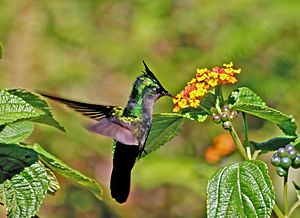
Lantana camara is originally from Central and South America. But now, it grows naturally in about 60 tropical and subtropical countries around the world. You can find it often in East and South Africa, usually below 2000 meters (about 6,500 feet) in altitude. It often grows in areas that have been disturbed, like logged forests or land cleared for farming.
This plant has also spread to parts of Africa, Southern Europe (like Spain and Portugal), the Middle East, India, tropical Asia, Australia, New Zealand, and the USA. It's also found on many islands in the Atlantic, Pacific, and Indian Oceans. For example, it became a big weed in Sri Lanka after it escaped from the Royal Botanical Gardens, Sri Lanka in 1926.
It was brought to the Philippines from Hawaii as part of a plant exchange program. However, it escaped and now grows wild on the islands.
The areas where Lantana camara grows are still getting bigger. It has invaded many islands where it wasn't present before, like the Galápagos Islands and the Solomon Islands. Even in places where it has been for many years, like East Africa and Australia, it continues to spread. This plant can quickly take over land that has been disturbed by things like logging, clearing for farms, or forest fires. However, in countries with large areas of untouched natural forests, Lantana camara doesn't spread as much.
How does Lantana camara affect its environment?
Where it lives
Lantana camara can live in many different places, including:
- Farm areas
- Edges and open spots in forests
- Areas near rivers
- Grasslands
- Secondary forest (forests that have regrown after being cut down)
- Beach fronts
It's rare to find Lantana camara deep inside natural forests. This is because it needs a lot of sunlight and can't grow well in the shade of taller trees. It prefers to grow at the edge of forests. Lantana camara can survive in many different weather conditions, including drought (very dry periods), different types of soil, heat, humidity, and even salty conditions. It can also survive fires pretty well and quickly regrows in burnt areas.
Why it's an invasive species
Lantana camara is considered a weed in many tropical areas where it has started to grow. In farm areas or regrowing forests, it can become the main shrub growing under the taller trees. It crowds out native plants and reduces biodiversity. When it forms dense thickets, it can slow down how fast forests regrow by stopping new trees from growing.
Even though Lantana camara itself is resistant to fire, it can change how fires behave in a forest. It can cause a lot of dead plant material to build up. This increases the risk of fires spreading to the canopy (the top layer of trees). This can be very damaging in dry areas, where fires can spread quickly and destroy large natural areas.
Lantana camara also makes farmland less productive. Its dense thickets reduce crop growth and make harvesting difficult. There are other problems too: Mosquitos that carry malaria and tsetse flies in Africa often hide in Lantana camara bushes.
However, in some places like the Western Ghats in India, Lantana camara doesn't seem to harm biodiversity. It just grows in the same moist areas as other plants.
There are many reasons why Lantana camara has been so successful at invading new places:
- Birds and other animals eat its fruits and spread its seeds far and wide.
- Animals don't eat it much because it's poisonous.
- It can grow in many different types of environments.
- More logging and changes to habitats have helped Lantana camara because it likes disturbed areas.
- It produces chemicals that stop other plants from growing nearby.
- It makes a huge number of seeds (up to 12,000 seeds per plant each year!).
Is it poisonous?
Lantana camara is known to be poisonous to farm animals like cattle, sheep, horses, dogs, and goats. The substances that cause this poisoning are called pentacyclic triterpenoids. They can damage the liver and make animals sensitive to sunlight. Lantana camara also releases chemicals (this is called allelopathy) that stop nearby plants from growing by preventing their seeds from sprouting and their roots from getting long.
It's not fully clear if Lantana camara is poisonous to humans. Some studies suggest that eating the green, unripe fruits can be toxic. However, other studies have found that eating ripe Lantana camara fruit is safe for humans.
How can we control Lantana camara?
To control invasive Lantana camara in the long term, we need to reduce activities that create damaged habitats. Keeping ecosystems healthy is important to stop invasive species from taking over and outcompeting native plants and animals.
Using nature to control it
Scientists have tried using insects and other biocontrol agents to control Lantana camara. It was actually the first weed ever targeted for biological control. However, none of these programs have been very successful, even though 36 different control agents have been used in 33 regions.
The main reason for this lack of success is probably that Lantana camara has many different hybrid forms and a lot of genetic diversity. This makes it hard for the control agents to target all the plants effectively.
Physical removal
Mechanical control means physically removing the plants. You can pull them out or cut them down. This method can work, but it takes a lot of effort and money. So, it's usually only used in small areas. Another way is to burn the area and then plant native species there.
Chemical treatment
Using herbicides (weed-killers) is very effective for managing Lantana camara. However, it can be expensive, which makes it hard to use in poorer countries where Lantana camara is common. The most effective way to use chemicals is to first mow the area and then spray it with herbicide. But this can have serious effects on the environment.
What are the uses of Lantana camara?
The stems of Lantana camara have been used to build furniture, like chairs and tables. But historically, its main uses have been for medicine and as an ornamental plant.
Medicinal uses
Studies in India have shown that Lantana leaves can have antimicrobial (fights germs), fungicidal (fights fungi), and insecticidal (fights insects) properties. Lantana camara has also been used in traditional herbal medicines to treat many health problems. These include cancer, skin itches, leprosy, rabies, chicken pox, measles, asthma, and ulcers.
Some scientific studies have also found good effects from Lantana camara. For example, one study found that an extract from the plant helped reduce ulcer development in rats. Plant extracts have also been used in Brazil to treat breathing problems.
As an ornamental plant
Lantana camara has been grown specifically for its beauty in gardens ever since Dutch explorers brought it to Europe. It's a popular ornamental plant because it can last a long time without water and doesn't get many pests or diseases. Lantana camara also attracts butterflies and birds, so it's often used in butterfly gardens, especially in Florida.
As a host plant
Many butterfly species feed on the nectar of Lantana camara. For example, Papilio homerus, which is the largest butterfly in the western hemisphere, is known to feed on its flowers.
What do the names mean?
The name Lantana comes from the Latin name of a tree called the wayfaring tree (Viburnum lantana). The flowers of this tree look very similar to Lantana flowers.
The word Camara comes from Greek. It means 'arched', 'chambered', or 'vaulted'.
Gallery
Images for kids
-
4.5 m (15 ft) tall shrubs infesting a native woodland area in Sydney
See also
 In Spanish: Lantana para niños
In Spanish: Lantana para niños


